As a Pulitzer Prize nominated war correspondent, American University alumnus Sid Balman Jr. never shied away from the most difficult aspects of human nature. So it should be no surprise that his latest novel, “Algorithms,” tackles every hot button topic of the age.
While “Algorithms” is the third book in Balman’s “Seventh Flag” trilogy, Balman said this novel can serve as a standalone adventure. “Algorithms” is set 30 years in the future, at the fall of modern civilization.
A post-apocalyptic story in the same vein as Cormac McCarthy’s “The Road”, “Algorithms” follows heroine Ademar Zarkan of the Seventh Flag series. Zarkan leads the Free People of West Texas in an alliance with Native Americans and the Indigenous people of northern Mexico, to rescue her granddaughter, Arwen, from a misandrist cult that seeks to exploit her unique mental connection with the “Terra-Algorithm.” The link ties Arwen to Blue-52 — the last blue whale on earth that is rumored to be the vessel for the ultimate power: all the data and algorithms from before the fall of civilization.
Balman’s story examines the rise of extremism, political corruption, the increasing prevalence of Artificial Intelligence, climate change and above all the power of family and humanity’s ultimate connection to the natural world. Light reading, right?
Balman still writes like a journalist who spent years reporting war, genocide and the attempted rehabilitation of extremists. He spends little time on frivolous prose, which is why the book can feel eerie at times: almost like a news dispatch from the near future. His work creates an uncanny valley of the possibilities faced by the United States, even if they are what Balman calls “exaggerated."
It’s his direct style of narration that creates some of the most powerful moments of the novel, as his frankness is a greater gut punch than any flowery language could manage.
“I wanted to sort of grab people by the collar, because I mean, those are things that are sort of happening now,” Balman said in an interview with The Eagle.
Ultimately, the story weaves with a strong thread of hope. The first part of the novel is largely dedicated to before “the Fall,” which details all the very good reasons society collapsed, but the second half has a distinct, subtle, note of optimism to it.
Balman revels in the beauty of the alliance between Zarkan and her Indigenous allies, highlighting the power true friendship has to create positive change.
This hope found in connection, however, wasn’t Balman’s original intention for the novel, which initially took a darker perspective. Balman’s content editor, Kleo Belay, encouraged him to take a different direction.
“I feel like we’re in a time of human evolution and a time on the planet where the stories that we tell have a great ability to influence our future,” Belay said. “And hopefully, help us navigate through these challenging times with great upheaval and change happening.”
She continued that the story could “help lead us as a species into a better, more optimistic future.”
Balman continued, “[Belay’s] lighter view, my darker view, we sort of met in the middle. And she made some very important suggestions that transformed the book.”
One of the significant contributions Belay made was to include the influence of Indigenous cultures as the North Star of the novel.
“To bring a book to life, to bring a story to life, it has to be real,” Balman said.
“Real,” as Balman sees it, begins with research. He’s incredibly meticulous, with even the most fantastical aspects of the novel being almost direct outtakes from reality. For example, the blue whale, Blue-52, is based on a blue whale that has a unique 52 hertz song. Another example of his thoroughness is the fact that the names of his characters derived from gravestones of people who actually lived in Delle, Texas.
Yet more than research, Balman bases his characters based on the world around him as well.
The gun-toting and unflinching women leaders of the novel are based on Balman’s mother and other Texas women, while Arwen is largely inspired by Belay. Balman said that real life experience is the best thing he can try to imbue his characters with. His solution to exploring identities other than his own is to dive into their world.
Belay, who is half-Indigenous herself, helped introduce Balman to the cultures his book attempts to capture, encouraging Balman to lean into closeness with nature.
“He really understood the power of nature and what translated into the Terra-Algorithm,” Belay said. “In the book, it's one of the algorithms that the title refers to.”
The antithesis of the algorithms that already consume our online lives, the book’s Terra-Algorithm is the indescribable thing that binds humans to life. The concept bears undeniable resemblance to the concept of Spirit shared by several first nations across North America.
Belay thinks her insistence and exposure to Indigenous cultures and people, combined with Balman’s move to the natural beauty of Texas, allowed him the optimism which appears in “Algorithms.”
“Under this steady guidance of my publisher, editors, particularly Kleo, I would say that [the book] does represent my journey too,” Balman said. “Living where I live, you can't help but feel that [hope] every day that the sun rises in the mountains in front of me and set in the mountains behind me.”
With “Algorithms,” the journey of the characters he’s spent years writing has come to an end, but Balman is already looking to his next project.
His next book, titled “The Mural,” will examine the effects of a mass shooting at elementary school in Texas. Inspired by artists who helped curate a mural to honor those who died in a mass shooting at Robb Elementary School in Uvalde, the story follows an artist who is selected to create a mural that commemorates the victims and examines what the need for such tragic artwork means about America.
No matter what his next endeavor entails, trust that Balman will be taking a look at the darkest, and now also the brightest, of humanity.
“Algorithms” is available on Amazon or Bookshop.org as of Aug. 1.
life@theeagleonline.com
This article was edited by Sara Winick, Patricia McGee and Abigail Pritchard. Copy editing done by Isabelle Kravis.





